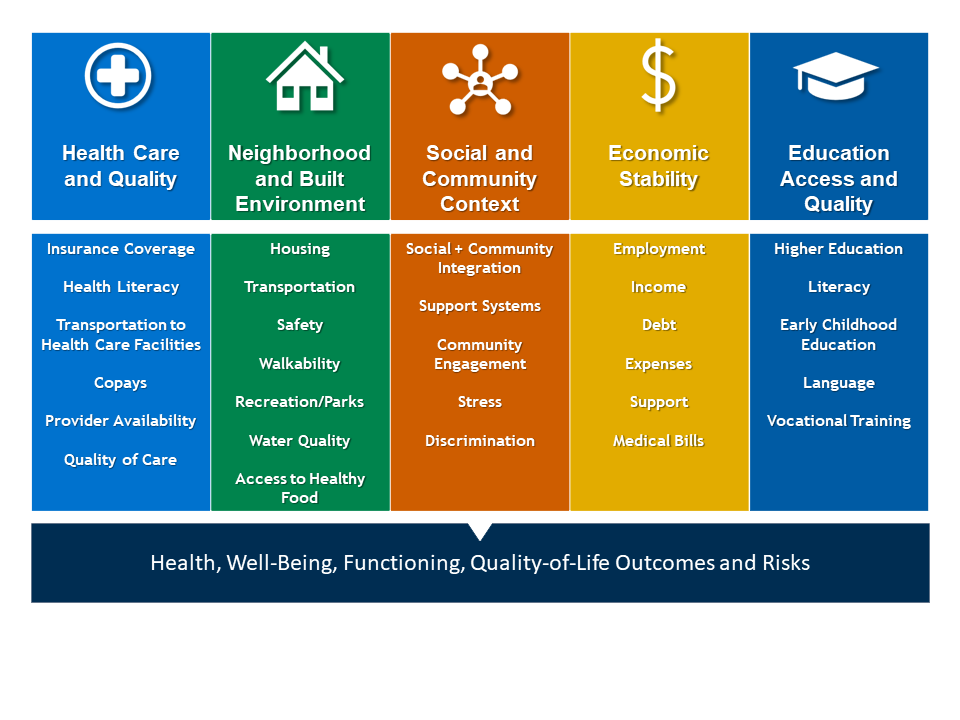
Traditionally, medicine has predominantly focused on diagnosing and treating specific clinical conditions, and not focused on social determinants. As medical knowledge has evolved and health systems shift towards value-based medicine, health care is beginning to acknowledge these non-medical conditions and their impact on health outcomes, health equity, and overall well-being.
These conditions, called Social Determinants of Health (SDOH) are conditions in the places where people are born, live, learn, and work that affect a wide range of health, functioning, and quality-of-life outcomes and risks. The five key domains of SDOH account for up to 75% of all health outcomes. These include health care and quality, neighborhood and built environment, social and community context, and economic stability, education access and quality.
SDOH research demonstrates time and time again that medical care alone is insufficient for ensuring better health outcomes. Providers are looking beyond office walls to understand the non-medical conditions that impact patient health. Health and well-being are not only being affected by medical treatment, but by our neighborhoods, our access to healthy foods, the quality of water we drink, our education systems, and by how safe we are where we work.

Health Care and Quality
1 in 10 people in the U.S. do not have health insurance, and nearly 1 in 4 people skip medical care because of the cost. Health insurance is critical in determining access to health care, which directly impacts health outcomes and quality of life. Besides insurance coverage, other factors that facilitate or hinder access to health care include health literacy, transportation to healthcare facilities, copays, and the availability of providers. Tactics to increase health care coverage and quality of health care are essential for more individuals receive critical services, such as preventative care and chronic illness management. By helping individuals get timely, high-quality health care services, the health outcomes of populations can be improved.
Neighborhood and Built Environment
The places where people live and work have considerable influence on their health and well-being. Sidewalks, walking trails, bicycle lanes, and green spaces in communities can improve physical activity and promote healthier living. Other elements in communities can negatively impact an individual’s health, such as living in neighborhoods with high rates of violence, unreliable transportation, unsafe water, and limited access to stores with healthy foods. Initiatives at the local, state, and federal level can help reduce community health and safety risks and promote healthier living.
Social and Community Context
Relationships and interactions with others can have a major impact on an individual’s health. As humans, we need social support and connection in the places where we work, live, and learn. Communities are implementing approaches to address these issues by focusing on factors such as civic participation, discrimination, incarceration and crime, social cohesion, and community capacity.
Economic Stability
In the U.S., 1 in 10 people live in poverty, and many can’t afford necessities like healthy foods, health care, and housing. Economic stability relates to employment and the ability to earn a reliable and livable income. It also includes safe and affordable housing and access to healthy and affordable foods. Interventions to address this SDOH focus on more people achieving economic stability. These programs assist in finding and keeping stable jobs and include employment programs, career counseling, and child-care opportunities.
Education Access and Quality
Statistically, individuals with higher levels of education are more likely to live longer and be healthier. Education typically results in better jobs, higher pay, and other benefits like better health insurance. These factors lead to better access to quality health care and healthier living. Children from low-income families, children with disabilities, and children who experience social discrimination are more likely to struggle with their core classes. These children are also less likely to graduate from high school or continue with higher education. This means they’re less likely to get high-paying, reliable jobs and more likely to have health issues in the future. Interventions to help children progress through school and help families afford college can have long-term health benefits.

